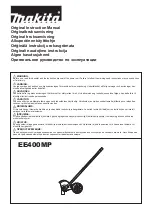
62-0074—1 B.B. Rev. 9-01
www.honeywell.com
C7057 CADMIUM SULFIDE PHOTOCELL
Printed in U.S.A. on recycled
paper containing at least 10%
post-consumer paper fibers.
Home and Building Control Home and Building Control
Honeywell
Honeywell Limited-Honeywell Limitée
1985 Douglas Drive North
35 Dynamic Drive
Golden Valley, MN 55422
Scarborough, Ontario
M1V 4Z9
Fig. 2. Vertical mounting configuration.
NOTES:
—
The photocell sensor has no polarity.
—
Wire to terminal strip T2, terminals 4 and 5.
—
Access to terminals can be gained through
standard conduit knockouts (A-E) located
around the perimeter of the enclosure.
—
Use knockout A only for the photocell sensor
and TOD wiring.
—
Photocell wires should be at least 18 AWG
two conductor. If not run in watertight conduit,
use suitable outdoor wiring insulation.
—
Shielded wiring is not required.
OPERATION AND CHECKOUT
In the following procedures, refer to the diagram inside
the CR7075A cover or Fig. 3. These show locations of
all operating controls, LED lights, and wiring connection
points.
Initial Adjustments
1.
Adjust both light level potentiometers to the fully
clockwise position (#1 index level).
2.
Place the SET-RUN switch to the RUN position.
Fig. 3. Wiring for 120 Vac input; 24 Vac load.
Calibration
After the controller and photocell sensor are installed
(with wiring and settings verified), and the photocell has
been exposed to light for 16 hours, apply power. The light
intensity threshold levels can be calibrated when the
desired outdoor light level has occurred.
NOTES:
—
Calibration achieves best results when
making adjustments at or near the light
conditions required for equipment switching.
—
Calibrating at extreme light conditions can
cause switching to be unachievable.
1.
At the desired outdoor light level place SET-RUN
switch to the SET position.
2.
Slowly rotate stage 1 light level potentiometer
counterclockwise until the stage 1 LED lights.
3.
Stage 1 is now calibrated to the light level existing
at the sensor and the stage 1 load is energized.
4.
Return the SET-RUN switch to the RUN position.
NOTE: To calibrate stage 2, repeat this process
except adjust the stage 2 light level
potentiometer.
IMPORTANT
After initial setup is complete, make certain the
switch is in the RUN position to avoid short
cycling the loads.
NOTE: The SET-RUN switch removes the integrating
time delay (short-cycle protection) circuitry in
the SET position. In the RUN position (normal
operation) the calibrated light level must be
present for 30 seconds before the load
switches.
M20060
HEX NUT
LENS
PHOTOCELL
JUNCTION
BOX
GASKET
1/2-14 THREADED
KNOCKOUT OR
7/8 INCH HOLE
FOR BEST RESULTS, EXPOSE LENS
TO LIGHT FROM THE NORTHERN SKY
(IN THE NORTHERN HEMISPHERE)
OR THE SOUTHERN SKY (IN THE
SOUTHERN HEMISPHERE).
USE WATERTIGHT JUNCTION BOX
WITH PROPER GASKETS AND SEALS.
1
2
2
1
CAUTION
ONE POWER SOURCE ONLY
LINE POWER
OUTPUT 1
OUTPUT 2
120
VAC
240
VAC
COM
N0
COM NC
N0 COM NC
M2032A
LIGHT LEVEL
SET
RUN
POWER STAGE 1
STAGE 2
1
2
3
4
5
6
7
8
9
10
1
2
3
4
5
6
7
8
9
10
T.O.D. 1
T.O.D. 2
SENSOR
1
2
3
4
5
T2
62-0074.fm Page 2 Friday, March 18, 2005 4:17 PM
By using this Honeywell literature, you agree that Honeywell will have no liability for any damages arising out of your use or modification to, the
literature. You will defend and indemnify Honeywell, its affiliates and subsidiaries, from and against any liability, cost, or damages, including
attorneys’ fees, arising out of, or resulting from, any modification to the literature by you.




















